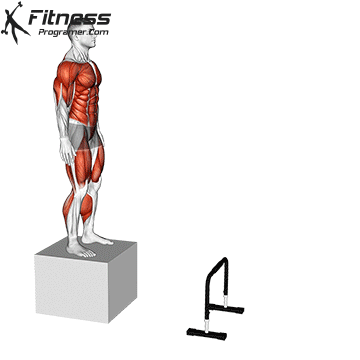Depth Jump to Hurdle Hop
The depth jump to hurdle hop is an advanced plyometric exercise frequently used in sports that require explosive power and agility. This exercise combines two plyometric movements: the depth jump and the hurdle hop. By incorporating this exercise into your training regimen, you can expect improvements in explosive power, agility, and lower body strength, making it a valuable tool for athletes aiming to excel in their respective sports.
how to do:

- Set up the Hurdles: Arrange a series of hurdles at different heights in a straight line, leaving enough space between them for you to land and hop between each one.
- Depth Jump:
- Stand on top of the plyometric box or platform with your feet hip-width apart.
- Start by stepping off the box and quickly dropping down to the ground, allowing your knees to slightly bend to absorb the impact.
- As soon as your feet make contact with the ground, immediately spring up explosively, using your arms for momentum.
- The depth jump is intended to be a quick and powerful jump, so make sure you’re not spending much time on the ground.
- Hurdle Hop:
- After the depth jump, immediately transition into the hurdle hop.
- As you ascend from the depth jump, aim to clear the first hurdle with a high knee lift.
- Land on the other side of the hurdle and quickly prepare for the next hop.
- Repeat: Continue performing the depth jump to hurdle hop sequence for the desired number of repetitions or for a set time period.
Tips:
- Focus on explosiveness and speed during both the depth jump and hurdle hop phases.
- Land softly on the balls of your feet to reduce impact and minimize the risk of injury.
- Maintain proper body posture and alignment throughout the exercise.
- Start with a low hurdle height and gradually increase it as you become more proficient.
- Ensure that you have adequate strength and conditioning before attempting this exercise, as it can be physically demanding.
Key Components of Depth Jump to Hurdle Hop:
Depth Jump: This exercise begins with a “depth jump” off an elevated platform or box. This initial drop stimulates the stretch-shortening cycle of your muscles, allowing for a more forceful contraction during the subsequent jump.
Stretch-Shortening Cycle (SSC): During the depth jump, the muscles undergo a rapid eccentric (lengthening) phase as you land, followed by an immediate concentric (shortening) phase as you jump vertically. This SSC recruits a large number of muscle fibers, enhancing force production.
Hurdle Hop: Following the drop, you transition seamlessly into a hurdle hop. In this phase, you explode upward and forward, propelling yourself over a hurdle or obstacle. This part of the exercise requires precise timing, explosive power, and excellent coordination.
Benefits:
- Explosive Power: The depth jump component of this exercise forces you to generate significant force quickly when pushing off the ground. This translates into improved vertical jump performance and sprint acceleration.
- Agility: Agility is the ability to change direction rapidly while maintaining balance and speed. The hurdle hops challenge your agility and coordination, helping you become more nimble and responsive in sports that require rapid direction changes and quick footwork.
- Lower Body Strength: As you repeatedly jump over hurdles, your leg muscles, particularly the quads, hamstrings, and calves, are engaged extensively, leading to increased lower body strength.
- Increased Power Output: The combination of depth jumps and hurdle hops focuses on maximizing power output. This can translate into improved sprinting speed, jumping ability, and overall athletic performance.
Muscles Worked:
Here are the primary muscles worked during this exercise:

- Quadriceps (Front Thigh Muscles): The quadriceps play a significant role in extending your knees and propelling you upward during the jump phase of the exercise. They are responsible for straightening your legs as you leap off the ground.
- Hamstrings (Back of Thigh Muscles): The hamstrings are activated during both the drop (eccentric phase) and jump (concentric phase) portions of the exercise. They help control the descent during the drop and contribute to the explosive upward thrust during the jump.
- Glutes (Buttocks Muscles): The gluteal muscles, particularly the gluteus maximus, are heavily engaged in generating power during the upward jump. They work alongside the quadriceps and hamstrings to provide the force necessary to propel you over the hurdle.
- Calves (Gastrocnemius and Soleus): The calf muscles play a crucial role in extending your ankles during the takeoff phase of the jump, contributing to your ability to spring off the ground and clear the hurdle.
- Hip Flexors: The hip flexor muscles, including the iliopsoas, are involved in lifting your legs and hips during the jump. They help bring your knees toward your chest and allow for hip flexion, which is vital for clearing the hurdle.
- Core Muscles: Your core muscles, including the rectus abdominis and obliques, provide stability and support during the exercise. A strong core is essential for maintaining proper posture and controlling your movements.
- Lower Back (Erector Spinae): The erector spinae muscles in your lower back help maintain an upright posture during the exercise. They provide stability and assist in controlling the descent and takeoff phases.
- Hip Adductors and Abductors: These muscles, located on the inside and outside of your thighs, respectively, help control the alignment of your legs and assist in maintaining proper form as you jump over the hurdle.
- Ankle Stabilizers: The muscles surrounding the ankle joint, such as the tibialis anterior and posterior, are essential for stabilizing your ankles and ensuring a safe takeoff and landing.
- Shoulder and Arm Muscles (to a lesser extent): While the primary focus of the Depth Jump to Hurdle Hop is on the lower body, your shoulder and arm muscles may also be engaged to help with balance and coordination.
